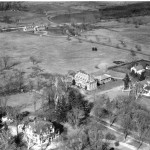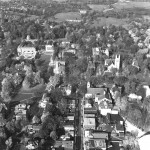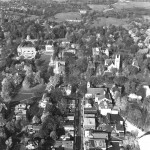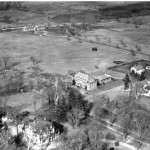Eric Outterson
November 20th, 2009
Natural History of the Berkshires
History
This week, I began an examination of the past which extended beyond the speculation of past visits to the Stetson parking lot woods. It began with a visit to the college archives to see if I could get a better look at my site through aerial photographs over time. Linda Hall greeted me at the elementary school and asked “Are you Eric Outterson?”
When I responded affirmatively, she promptly handed me a large box with many folders. She told me, “In this box we have folders of most of the aerial photographs of the campus, and folders of photos of areas of the campus labeled by their location.” I stared at the intimidating box, and decided that the only way to get through it was to start opening the folders.
In the aerial photographs box I found a large collection of photographs extending from the 1930’s onwards. Unfortunately for me, most of the aerial photography was of campus icons like Thompson Memorial Chapel, Griffin Hall or West College. The small patch of woods that now makes up my site is situated behind Thompson Memorial Chapel and Griffin Hall. As a result, many of the angles on my site were not great. Most were photographs which cropped out the trees.
Though there was a slightly larger timeframe in which I could see my site, from the limited set of photographs that remains, aerial and otherwise, I have approximately 3 windows of time in which I could see my site well.
These were around 1900, 1941 and 1962. There was also one illustration from 1889. In the illustration, there was a small stand of trees immediately behind griffin hall (labeled 16) and behind Goodrich (Old Goodrich).

Williamstown, Mass. Drawn and published by L. R. Burleigh. Burleigh Lith. Est.
Burleigh, L. R. 1853?-1923. (Lucien R.), Troy, N.Y., 1889.
In later photographs, like those from around 1900. In this photo dating before 1902 (we know that it’s before 1902 because the chemistry annex which is visible in the photo was removed from griffin hall), there is a shot of where my site was taken potentially taken by amateur photographer Cyrus Morris Dodd.

You can see goats in the picture grazing on the large stretch of land that is now the lower Stetson parking lot.  To determine where the current Stetson parking lot woods is, one must be careful, because in 1904 Griffin Hall’s foundation was moved 100 feet northeast. After estimating the 100 foot move, it seems that in my site, you can see a few trees but nothing very lush. It’s hard for me to guess what they might be exactly
Looking ahead to 1941 it looks like there are more trees in the area that are my site. It’s still difficult to identify any of them, but they do not look at all cultivated.

In photographs that follow, it seems that woods slowly gains more density even though the areas around it are always well cut by grasses and other things.
Between the founding of Williamstown in 1753 and the first visual evidence of the land being cleared in 1890, the trees were largely cleared. I venture to guess that the trees were actually cleared much earlier, possibly around the 1830’s when Williamstown was at its agricultural land peak or in 1827 when Griffin Hall began construction. After Griffin Hall’s construction, the land was largely cleared and used as pasture.
From 1900 onwards it seems the small number of trees increased quickly. In photos of the Roeper center construction the stand of trees looks very thick, approximating what it looks like today.




 This is a drawing that appeared in Durfee’s Biographical Annals in 1871. As can be seen, the surrounding area is for the most part empty of trees. Keep in mind, however, that this is an artist’s interpretation of the site, and that the monument is actually much smaller than it is portrayed here.
This is a drawing that appeared in Durfee’s Biographical Annals in 1871. As can be seen, the surrounding area is for the most part empty of trees. Keep in mind, however, that this is an artist’s interpretation of the site, and that the monument is actually much smaller than it is portrayed here. Sage and WIlliams Annexes are the two houses below Williams and Sage Halls where Mission Dormitory now stands. My site (between the annexes and the halls) seems similarly forested then to how it is now.
Sage and WIlliams Annexes are the two houses below Williams and Sage Halls where Mission Dormitory now stands. My site (between the annexes and the halls) seems similarly forested then to how it is now.